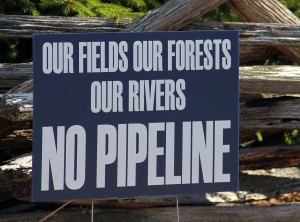Conservation groups are rallying against the Mountain Valley Pipeline
From an Article by Hilary Hanson, Huffington Post, 12/17/2016
Environmental groups are voicing opposition to a proposed natural gas pipeline that would cut across the Appalachian Trail in Virginia and require clearing a previously protected corridor of forest.
The Mountain Valley Pipeline would transport natural gas from northwest West Virginia to southern Virginia, according to The Wilderness Society, which published an editorial this week saying the pipeline would set a “dangerous precedent.” That’s because construction would involve clearing a 125-foot-wide section that would cross 3.4 miles of forest protected under the Forest Service’s “roadless rule ― litigation meant to protect lands from road construction and logging.
“Some of the most iconic viewpoints, like Angels Rest, along the Appalachian Trail in Virginia will look out upon an ugly swath of destruction that dissects habitat and threatens waterways,” the Wilderness Society writes.
Specifically, the pipeline would cross Jefferson National Forest in West Virginia and Virginia, pass through the Appalachian National Scenic Trail Corridor and cross the Appalachian Trail near Virginia’s Peters Mountain Wilderness Area, according to the conservation group Wild Virginia.
Multiple environmental groups said this month that they refused to even comment on the government’s Draft Environmental Impact Statement for the project because the draft has so many errors.
Other concerns include the public safety of residents, businesses and community organizations that would find themselves in the “blast zone” — a radius of about 1,115 feet around the pipeline where an explosion could have a “significant impact on people or property.” In Newport, Virginia, that zone includes historically significant buildings as well as residents’ homes, according to The Roanoke Times. Other Virginians have expressed fear about threats to groundwater, given the porous nature of the karst landscape of the state’s Giles County where some of the pipeline is slated to go.
Pipeline supporters include Virginia Gov. Terry McAuliffe (D) and local business leaders, who say the project would create jobs, lower energy costs and potentially attract new business.
A public comment period on the project will run through December 22nd. Anyone can file a comment on the Federal Energy Regulatory Commission website, or call or write to FERC Secretary Kimberly Bose. The Appalachian Trail Conservancy has also put together a comprehensive guide on how to contact members of the Virginia and West Virginia legislature and representatives of the U.S. Forest Service.
See also: www.FrackCheckWV.net


{ 2 comments… read them below or add one }
Campers, Hikers, Enviros Fight Pipeline Across the Appalachian Trail
From Charles Mello, Adventure Journal, December 20, 2016
Natural gas route would cut 125-foot path across 300 miles of West Virginia and Virginia forest—and isn’t needed to meet demand.
Yes, the Appalachian Trail crosses lots of roads and infrastructure. But wilderness and untrammeled land are at a premium in the Anthropocene, especially in the U.S. eastern seaboard, and the increasingly rare experience of solitude is being threatened by a proposed gas pipeline.
The Mountain Valley Pipeline would run 300 miles across West Virginia and Virginia, carrying natural gas from Bradshaw to south of Lynchburg, where it would connect with another pipeline.
“Cutting through one of the most celebrated hiking trails in America, the proposed Mountain Valley Pipeline threatens wildlife habitat, recreational lands and the health of local Appalachia communities, while setting a terrible precedent of building energy infrastructure through our national forests,” wrote the Wilderness Society.
It would also violate the 2001 U.S. Forest Service roadless rule, which blocks construction of roads and other infrastructure in the 58.5 million acres of national forest that have been inventoried as roadless.
The pipeline also is unnecessary. A study conducted in fall 2016 looked at the MVP project and another proposed 550-pipeline and found that current capacity is more than enough to last through 2030 at least. “Additional interstate natural gas pipelines, like the Atlantic Coast and Mountain Valley projects, are not needed to keep the lights on, homes and businesses heated, and existing and new industrial facilities in production.” wrote the researchers.
“The dilemma for communities up until now has been figuring out where these pipelines would be built,” said Greg Buppert of the Southern Environmental Law Center. “But today we know they don’t need to be built at all. Despite what we have heard from the utilities, we will have plenty of power and heat without them.”
Whether to allow the pipeline is up the Federal Energy Regulatory Commission, which is taking comments through December 22nd.
Source: https://www.adventure-journal.com/2016/12/campers-hikers-enviros-fight-pipeline-across-appalachian-trail/
See also: http://www.FrackCheckWV.net
I live in eastern Ohio, in the middle of Utica shale.
The drilling has ruined our lives here.
The pipelines and compressor stations are everywhere.
There are few local jobs and the politicians don’t live here.
The noise comes into our houses and the energy companies could care less.
joe perebzak